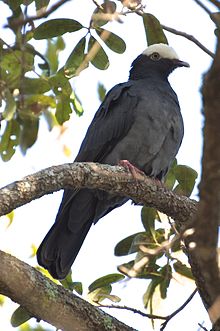White-crowned pigeon
| White-crowned pigeon | |
|---|---|
 |
|
| In Florida, USA | |
| Scientific classification | |
| Kingdom: | Animalia |
| Phylum: | Chordata |
| Class: | Aves |
| Order: | Columbiformes |
| Family: | Columbidae |
| Genus: | Patagioenas |
| Species: | P. leucocephala |
| Binomial name | |
|
Patagioenas leucocephala (Linnaeus, 1758) |
|
| Synonyms | |
Columba leucocephala Linnaeus, 1758
The white-crowned pigeon (Patagioenas leucocephala, formerly Columba leucocephala) is a species of bird in the family Columbidae (doves and pigeons). It inhabits the northern and central Caribbean islands and some places on the North and Central American mainland. John James Audubon painted the pigeons, including the watercolour in his work Birds of America, published in the early 19th century.
The white-crowned pigeon can measure 29–35 cm (11–14 in) in length, span 48–59 cm (19–23 in) across the wings, and weigh 150–301 g (5.3–10.6 oz). It is around the same size as the common rock pigeon, but weighs a bit less since it is generally less chunky and has a relatively longer tail. The adult is dark grey, with green and white bars on the nape, a brilliant white crown to the head, a white iris, and a pale-tipped red bill. Juveniles are a less dark shade of grey, lack the nape pattern and white iris, and show only a few pale feathers on the crown. The song is a series of mourning dove-like woo pop woooo calls; this species is a member of a diverse clade of Patagioenas which vary much in appearance, but are united by their triple coos (except in the scaled pigeon).
It is a resident breeder mainly in the Bahamas, Cuba, Jamaica and Antigua. It breeds in smaller numbers in Hispaniola, Puerto Rico, the Virgin Islands, the Cayman Islands, Anguilla and other Caribbean islands. It also breeds along the Caribbean coast of Central America. In the United States it is found only in the Florida Keys and the southern tip of mainland Florida.
...
Wikipedia

